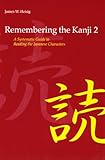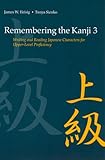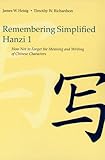Learning Kanji Using Imaginative Memory
 When I first began learning Japanese in college, I made the same mistake most learners of Japanese or Chinese do: I tried to learn characters the way they are taught in traditional language classrooms and textbooks. The traditional method (i.e. using pure, tedious, rote memorization) is also used by Japanese and Chinese children when learning to write their native tongues. It also happens to be the slowest, least effective and most nerve-racking way for non-native adults to master Chinese characters.
When I first began learning Japanese in college, I made the same mistake most learners of Japanese or Chinese do: I tried to learn characters the way they are taught in traditional language classrooms and textbooks. The traditional method (i.e. using pure, tedious, rote memorization) is also used by Japanese and Chinese children when learning to write their native tongues. It also happens to be the slowest, least effective and most nerve-racking way for non-native adults to master Chinese characters.
Luckily, I was introduced to a book called Remembering the Kanji by James Heisig shortly after beginning my Japanese studies. Using this book, I was able to learn the meaning and writing of each and every “standard use character” in modern Japanese (JōYō KanJi 常用漢字) in a matter of months, not years or decades like so many unfortunate language learners before me.
Many years later, I still remember each and every character presented in the book, and better yet, I have been able to apply the same method to easily acquire additional Chinese characters and traditional forms used in Taiwan, but not Japan. Heisig has actually created 2 Chinese specific versions as well, one for the traditional characters used in Taiwan and Hong Kong, and one for the simplified forms used in Mainland China (Remembering Traditional Hanzi and Remembering Simplified Hanzi).
Heisig defines imaginative memory as “the faculty to recall images created purely in the mind, with no actual or remembered visual stimuli behind them. When we recall our dreams we are using imaginative memory. The fact that we sometimes conflate what happened in waking life with what merely occurred in a dream is an indication of how powerful those imaginative stimuli can be” (Heisig, 3).
The method works as follows:
- Characters are broken down into “primitive elements,” useful stroke combinations that appear in multiple characters. Some characters then go on to become primitives in additional characters.
- Combining these primitive elements, the learner then creates a highly visual, goofy, wild, zany, outrageous, completely unforgettable story or image in their imaginative memory.
- And that’s it! Instead of trying to remember specific strokes (difficult!), you just have to recall a vivid story or image (easy!) Moreover, there is no need to rewrite the character thousands of times; you need only write it as many times as needed to practice proper proportion and style.
Take Action
- Purchase the appropriate book for your level and target language (click the book covers below to buy them on Amazon).
- Make sure to read the introduction carefully. To make the system work, it is essential that you follow the methods detailed there.
- Create a realistic study schedule that you can stick to day in and day out. It is far better to study fewer characters everyday than doing infrequent marathon sessions.
Republishing This Article
Want to share this on your site or blog? You are welcome to republish any articles by John Fotheringham. For guest posts, you must seek permission from the post author. For John's articles, please include the following at the top and bottom of the article when reposting:
Copyright © 2010 by John Fotheringham. For more tips, tools, and tech for Mastering ANY Language, go to LanguageMastery.com






I maintained a daily record of how I acquired about 4000 Chinese characters in my first year of study. I find that the elements are important, but Ash Henson and I are big proponents of 諧聲字 (phonetic compounds) because almost exactly 90% of the 50,000+ characters belong to this category enabling you to remember their pronunciation. This, along with the stories or histories of the characters, provides yet another anchor in my memory.
Hi Everyone.
I suddenly became quite interested when you mentioned the phonetic compounds.
I was wondering if you have or know of any time saving method to study with the compounds?
I noticed http://www.zhongwen.com breaks characters down into phonetics sometimes, but so far I don't have a systematic methodology using phonetics.
Just curious
For Japanese, Heisig created a second book called "Remembering the Kanji 2" that teaches you how to pronounce all standard use characters, with a major emphasis on phonetic components.
Unfortunately, he has yet to release such a version for simplified or traditional Chinese.
Online resources like Zhongwen.com are great, but in my experience, are best suited as a reference resource, not a method for actually learning characters. When I do want dig into a character's phonetic and ideographic components, I prefer YellowBridge.com, which I have just reviewed here:
http://l2mastery.com/featured-articles/review-of-...
I agree. Learning to leverage phonetic patterns greatly improves one’s ability to guesstimate the reading of unfamiliar characters that contain familiar phonetic components. Can you share a link with us to your “Daily record” or was it done off-line?
[...] Read my post Chinese Characters: How to Learn the Traditional & Simplified Forms Using Imaginative Memory. [...]
[...] Read my post Chinese Characters: How to Learn the Traditional & Simplified Forms Using Imaginative Memory. [...]